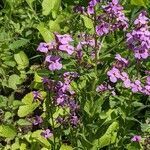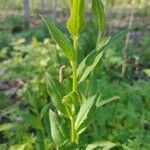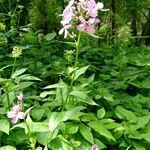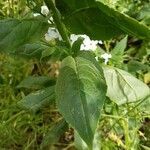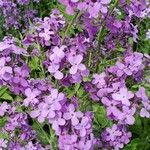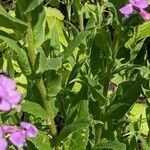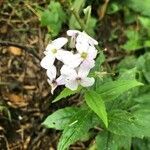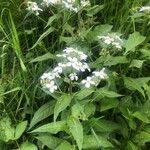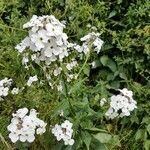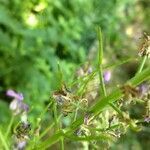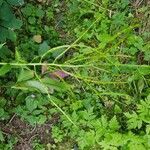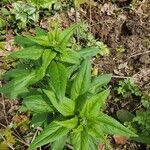Stems unbranched basally, often branched distally, 4-8(-11) dm, often eglandular, glabrous distally. Basal leaves withered by flowering, long-petiolate. Cauline leaves short-petiolate; blade narrowly oblong, lanceolate, or broadly ovate, (2-)4-15(-20) cm × (4-)8-40 (-60) mm, base cuneate, margins denticulate or entire, apex acute or acuminate, surfaces pubescent. Fruiting pedicels (5-)7-17(-25) mm. Flowers: sepals 5-8 × 1.5-2 mm; petals (13-)15-20(-22) × 3.5-9 mm, claw 6-12 mm; filaments 2.5-6 mm; anthers 2.5-4 mm. Fruits (4-)6-10(-14) cm × 2-2.5 mm. Seeds (2.5-)3-4 × 1-1.5 mm. 2n = 24.
Erect biennial or perennial 5–10 dm, often branched above; lvs lanceolate or deltoid-lanceolate, short-petioled or sessile, remotely and sharply denticulate, pubescent above with simple hairs, below chiefly with branched hairs; sep ± pubescent, fls fragrant; pet purple, varying to pink or white, 2–2.5 cm; frs 5–10 cm, somewhat constricted between the seeds; 2n=16, 24, 26, 28, 32. An old-fashioned ornamental, escaped along roads and in open woods and moist bottomlands; Que. and N.S. to Mich. and Io., s. to Ga. and Ky. May, June.
Biennial or perennial up to 1 m tall; rootstock woody; hairs simple and branched. Lvs ovate, hairy, simple, toothed, tapering to petiole; lower lvs to 50 × 10 cm, petiolate; upper lvs smaller, narrower, very shortly petiolate. Racemes 10-20 cm long. Sepals hairy with scarious or pinkish margins, 5-7 × c. 2 mm. Petals white to violet, 12-15 × 4-5 mm. Silique curved, 60-100 × 1.5-2 mm, erect on spreading pedicels 10-20-(30) mm long; valves ± glabrous, constricted between the seeds. Seeds brown, 3-4 mm long.
A cabbage family herb. It is an upright annual plant. It grows 60-90 cm high and spreads 60 cm wide. The leaves are smooth, slim and oval. They are 20 cm long. The flower heads are branching. The flowers occur in clusters. The flowers are 40 mm across. They can be white to pale lilac.
